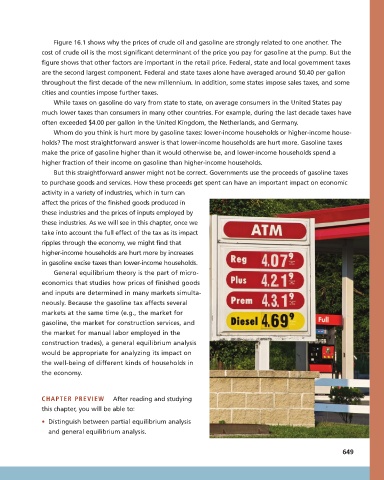Page 675 - Microeconomics, Fourth Edition
P. 675
c16GeneralEquilibriumTheory.qxd 8/16/10 9:13 PM Page 649
Figure 16.1 shows why the prices of crude oil and gasoline are strongly related to one another. The
cost of crude oil is the most significant determinant of the price you pay for gasoline at the pump. But the
figure shows that other factors are important in the retail price. Federal, state and local government taxes
are the second largest component. Federal and state taxes alone have averaged around $0.40 per gallon
throughout the first decade of the new millennium. In addition, some states impose sales taxes, and some
cities and counties impose further taxes.
While taxes on gasoline do vary from state to state, on average consumers in the United States pay
much lower taxes than consumers in many other countries. For example, during the last decade taxes have
often exceeded $4.00 per gallon in the United Kingdom, the Netherlands, and Germany.
Whom do you think is hurt more by gasoline taxes: lower-income households or higher-income house-
holds? The most straightforward answer is that lower-income households are hurt more. Gasoline taxes
make the price of gasoline higher than it would otherwise be, and lower-income households spend a
higher fraction of their income on gasoline than higher-income households.
But this straightforward answer might not be correct. Governments use the proceeds of gasoline taxes
to purchase goods and services. How these proceeds get spent can have an important impact on economic
activity in a variety of industries, which in turn can
affect the prices of the finished goods produced in
these industries and the prices of inputs employed by
these industries. As we will see in this chapter, once we
take into account the full effect of the tax as its impact
ripples through the economy, we might find that
higher-income households are hurt more by increases
in gasoline excise taxes than lower-income households.
General equilibrium theory is the part of micro-
economics that studies how prices of finished goods
and inputs are determined in many markets simulta-
neously. Because the gasoline tax affects several
markets at the same time (e.g., the market for
gasoline, the market for construction services, and
the market for manual labor employed in the
construction trades), a general equilibrium analysis
would be appropriate for analyzing its impact on
the well-being of different kinds of households in
the economy.
CHAPTER PREVIEW After reading and studying
this chapter, you will be able to:
• Distinguish between partial equilibrium analysis
and general equilibrium analysis.
649

